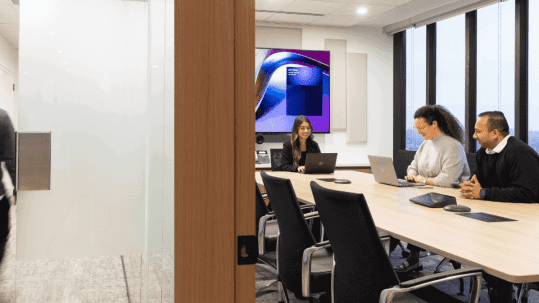Retaining talent has always been a challenge for employers with skilled staff regularly jumping ship for better perks or higher pay. The pandemic has been a tricky time that’s slowly but surely changed what people are looking for. As COVID-19 took us by storm, employees quickly transitioned to working from home, some lost their jobs, and many worried about the future of their careers for the very first time. Those returning to work came back with heightened sensitivities and new expectations for sanitary work environments. Some fell in love with the work from home (WFH) arrangement and others couldn’t have been more eager to return to a productive physical office space.
What’s important to people is changing. Now that employees and prospective candidates are redefining what matters to them in a working relationship, how can you keep up with new demands and be sure you’re offering the most competitive work experience possible?
Here are 5 retention strategies for holding on to your talent in 2020 and well beyond the pandemic.
1. Continue with WFH arrangements and flexible hours
You and other leaders in your company might have resisted the idea of work from home arrangements in the past if you were worried about productivity loss. Chances are your attitudes have shifted, and you’re not the only one! A PwC survey that interviewed CFOs found that 63% of respondents were concerned about losing productivity due to remote work in March, but in June, the number was down to only 26%.With renewed trust in employees getting the job done from wherever they are, working from home is a trend that’s here to stay. Research we did at Aura found that 68% of respondents expect their teams to be working from home 2-3 days a week in the future.
Offering WFH arrangements even after the pandemic has passed is an easy way to stay relevant as a great place to work by offering your staff better work/life balance. You may also want to consider offering more flexible hours too. If not all work has to be in by 5 PM, then it might be time to expand your definition of flexible hours to encompass more options than you’ve given before.
You can take matters a step further by developing new categories of time off that can help make life easier for your employees. One thing marketing agency Mighty Citizen does to support their employees is giving them 3.5 hours per month separate from paid time off. Employees can use this time to take care of doctors appointments and day-time errands that they usually sacrifice their lunch hours to attend to. It’s a very simple benefit that can be highly appreciated!
2. Compensate WFH expenses with home office stipends
If offering work from home arrangements is right for your company you now have an opportunity to save on the overhead costs of a large office space and instead invest in keeping your employees happy at home. To get the most out of your remote workforce, you’ll want to ensure they’re well equipped to do their jobs comfortably. You can offer WFH office stipends that can be used towards laptops, monitors, standing desks, and comfortable office chairs. Shopify and Google are both offering their workers $1,000 to purchase office supplies, furniture, and equipment. Other ideas are including a monthly high-speed Wi-Fi allowance and even a Spotify subscription for that background music. There’s plenty of opportunity to get creative with this one!
3. Build intentional culture online
You might worry about your culture slowly vanishing without much face-time or those watercooler chats happening in-office like they used to. Culture can certainly transcend the physical office space, but it’s up to you to make more intentional efforts for this to happen.
Here are a few ideas:
- Host virtual team gatherings
Set monthly or weekly company-wide virtual meetings for teams to share status updates, interact with other departments, and make sure everyone’s on the same page. These meetings can even be totally non-work-related too. You can use them as an opportunity to discuss hobbies and topics outside of work to get to know one another on a more personal level. This will help employees who can feel isolated at home enjoy a sense of belonging. - Get the most out of collaboration platforms
Collaboration platforms like Slack, Microsoft Teams, and Zoom are loaded with little ways to speed up teamwork, keep culture norms going, and build morale.
Let’s take Slack for example. With features like polls, mentions, reactions, add-on apps, and the ability to create topic-specific channels like #dogs or #memes, the possibilities are endless for sharing praise and appreciation, gathering real-time feedback, and keeping those watercooler chats going in the digital world.
For a deeper dive into some of Slack’s features check out this blog post by Assembly.
- Make extra efforts to onboard and integrate new talent
New hires now have a much harder time making new connections without the chance to run into people at the office. With less face-time, it’s essential to make your best efforts to proactively introduce newcomers to the rest of the team and make them feel welcome.
Back to using Slack as a tool, adding in the donut app is one way to randomly match two employees in your company together to enjoy a quick donut or coffee together in-in office or virtually. It’s an easy and simple way to make those introductions.
4. Step up your health and safety measures
One thing we’ve learned through recent research at Aura is that even though workplaces are changing with more WFH arrangements and digital meetings, the physical office isn’t going away anytime soon.
With an intrinsic need to connect with other people, a chunk of the workers will still choose to come into the office for meetings and socialization. It’s our job as employers to make sure our offices safe spaces to return to.
- Start by updating your health and safety policies and cleaning protocols. Communicate these new policies to the entire team to ensure that they’re understood and followed.
- Reconsider the type and frequency of your office’s cleaning method. This can mean having your janitorial service come in more often than they currently do, or better yet making the switch to more intensive cleaning methods like electrostatic disinfecting to minimize the spread of viruses and reduce the chance of cross-contamination within the office.
- Invest in touchless technologies like touchless coffee machines, meeting room booking apps, and that hot desk booking software can help you avoid the spread of germs, track office visitors, and manage daily headcounts in-office.
5. Review your benefit packages
There’s no time like right now to review your total compensation packages by taking a closer look at health insurance coverage, professional development allowances, and paid time off.
- Re-evaluate your health insurance packages
Following the pandemic, people are more concerned about what exactly their health insurance covers. Take some time to evaluate your health insurance package and pay close attention to matters like short and long term disability options. If there’s room in your budget to upgrade your packages, go for it. - Set separate allowances for mental health
Mental health services like counseling are typically covered in health insurance packages, but with therapy costing a couple hundred dollars a session, it’s easy for employees to run out of their allowances quickly. Not only so, but the pandemic has negatively impacted the mental health of many, requiring even more care than usual. One company that’s paying good attention to the mental health needs of its employees is Thinkific. It currently offers its employees a $2000 mental health allowance as part of its benefits package. - Offer professional development opportunities online
Growth has always been an important deciding factor for whether or not an employee sticks around. It may seem like professional development opportunities are harder to come by now with conferences and lunch-and-learns being canceled for the time being. But you can still offer some great professional development or education allowances that can be used online towards virtual conferences, Masterclasses, and various training courses. PageFreezer, for example, offers its employees a $1000 professional development fund to spend as employees desire.
These online learning opportunities can still improve staff engagement with the company, personal motivation, and productivity in their roles.
Retaining employees has always been difficult, and as times change it’s important to be adaptive, both to keep your employees happy, and appeal to more talent as a great place to work. The thought and strategy put into your retention efforts can say a lot about your organization’s brand.
We’ve explored a few ideas, but remember that choosing the right retention strategy will depend on your unique workforce. Be sure to carefully listen to what your employees want before you pull the trigger on any decisions. Employees are likely to feel even more valued when you consider their feedback and make conscious efforts to respond to their needs.






